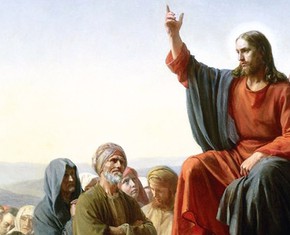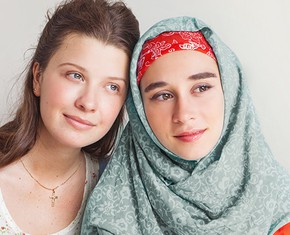The views expressed in our content reflect individual perspectives and do not represent the authoritative views of the Baha'i Faith.
On December 24th of 1920, in Manhattan, Sarah Caroline Stright (1871–1951), a White woman, married the Rev. James T. Simpson, a Black widower with four children.
Interracial marriages were not common in America during the 1920s. They were illegal in many states, but they did happen.
RELATED: So That Worldly Prejudices May Not Remain
The Baha’i Faith, however, strongly encouraged interracial marriage – as part and parcel of its principle of the unity of humankind and the eradication of all prejudice. Baha’u’llah, the prophet and founder of the Baha’i Faith, wrote:
O ye children of men! The fundamental purpose animating the Faith of God and His Religion is to safeguard the interests and promote the unity of the human race, and to foster the spirit of love and fellowship amongst men. …
O contending peoples and kindreds of the earth! Set your faces towards unity, and let the radiance of its light shine upon you. Gather ye together, and for the sake of God resolve to root out whatever is the source of contention amongst you.
Abdu’l-Baha, Baha’u’llah’s son and successor, enthusiastically approved of interracial marriage despite the miscegenation laws in many places, and supported the wishes of many interracial Baha’i couples to wed. Shoghi Effendi, the Guardian of the Baha’i Faith and Abdu’l-Baha’s successor, said in Directives from the Guardian that:
… the principle of the oneness of mankind prevents any true Baha’i from regarding race itself as a bar to union … For both Baha’u’llah and Abdu’l-Baha never disapproved of the idea of interracial marriage, nor discouraged it. The Baha’i Teachings, indeed, by their very nature transcend all limitations imposed by race, and as such can and should never be identified with any particular school of racial philosophy.
So in 1920 Reverend James Simpson and Sarah Caroline Stright married in Manhattan, according to New York City’s Marriage Records. However, by 1927 one would not know that Caroline was James Simpson’s wife, based on his biographical mention in Who’s Who in Colored America.
James Simpson had finished Brooklyn Law School in 1923, and was working as a lawyer in 1927. Born in Canadensis, Pennsylvania in 1871, Caroline Simpson was White, according to the United States Census of 1880. Caroline’s father was born in England, and her mother was born in Pennsylvania. But Caroline may have somehow later passed as Black, since the 1925 New York State Census lists her race as “Black.”
Here’s part of the story leading up to this interracial marriage, beginning with the following 21 August 1920 letter from Reverend Simpson to Miss Ella M. Robarts, a Baha’i in Boston:
My dear Sister …
This is to inform you that I received the letter that you wrote to me just before you came to Green Acre [Baha’i School]. Of course, the matter contained therein has been answered; yet I will add that I appreciate the interest that you have manifested and will state that the future Mrs. Simpson will look after the matter of what you spoke. She will be the North African Correspondent. She will attend to that part of it. She will work among our native children too. Oh, there are many many things she can and will do in that connection! …
Hoping to hear from you soon praying that Bahaullah be upon you, I remain, faithfully,
Your brother in Baha-el-Abha,
James T. Simpson
P.S. I shall disclose the identity of the future Mrs. Simpson very soon, in accordance with the promise I made you. J.T.S.
Here, Reverend Simpson promised that the “the future Mrs. Simpson” would “be the North African Correspondent” of a planned Baha’i outreach to Morocco and North Africa.
However, six years later, by June of 1926, Caroline was no longer living in New York City with Rev. Simpson. The Baha’i News Letter reported that she had been elected secretary of the new Montclair Spiritual Assembly, in New Jersey: “During June another new Spiritual Assembly came into being in New Jersey, that of Montclair. Mrs. Caroline Simpson, secretary, writes that ‘we are in complete love and unity, and beg you to pray that we may attract many souls to His Kingdom’.”
RELATED: Why Would a Harlem Preacher Visit Africa to Teach the Baha’i Faith?
However, it does not appear that Caroline Simpson was “in complete love and unity” with her husband, James at that point, at least according to this letter she sent him in 1926:
… Just a line as the pages in one life keep turning. I feel much better satisfied now and shall go on earnestly with the tasks at hand. We are told to think of the good qualities and remember them. So lets. You refered to those painful bitter scenes (many happy couples experience hard storms then kiss and make up). Now let me remind you that after these were all over, you were very sweet and affectionate, tho I was pretending to be angry. I was pretending only, because you had hurt me so deeply that I thought you ought to make it right. But I often had to turn away to keep you from seeing me laugh. For me to hold anger is an impossibility. – But while you continued [illegible word] away you would always say sweet things always wanting my sympathy and love you know. This is true. It was after I came away that you started to condemn me.
So now we have this straight and it does not matter. I understand all about it now.
I know I neglected you for John. You see John was saved – he had been an outcast from his school his family and society — couldn’t you have had a little patience? In the end I was [illegible: “a nervous”?] wreck and all to pieces! Was it worthwhile? If after it was over I broke down and went [illegible: “into a”?] tantrum, it was no crime. Even now I do not regret the price I paid to give to save the child.
Baha o llah will hold him now until his Bahai education is started in earnest.
You will be interested that I am going to buy some very [illegible: “expensive”?] clothes this week [as] I have to dress well in my work. If I [illegible] …
Without any further information on Rev. Simpson’s relationship to the “Baha’i Movement,” we do not know if he ever made it to Morocco, or why his marriage to Caroline Simpson did not survive. Back then, the American Baha’i community was still in its formative period. Unlike today, Baha’i community-building resources and practices were not available at that time.
Abdu’l-Baha was so robust an advocate of racial unity that he greatly encouraged interracial marriage. But interracial marriage, like all unions, can only work if the marriage itself is strong and enduring. In this sense, one of the most profound personal experiences of interracial unity can be found in such marriages. Yet, especially in deeply racist societies, they can also prove to be the most challenging test of the vitality of interracial unity.
So Rev. Simpson’s lofty initial plans, shared by Caroline Simpson, to spread the Baha’i message in Morocco and North Africa ultimately may not have succeeded, given that their interracial marriage itself did not succeed. In the “United States Census, 1930,” James T. Simpson is listed with his four sons, James L Simpson, Jr. (17), Windell P. Simpson (16), John M. Simpson (14), William L.G. Simpson (12). Caroline Simpson is no longer part of the household.
The period of Simpson’s involvement with the First Emmanuel Church and its Baha’i-related race amity projects, at first, had an “almost miraculous” program of action surpassing “the color line” and engaging directly the “most vital and challenging issue” of racism in America. But all that occurred in a bubble, and then the bubble burst. Here’s certainly one evidence of that: Rev. Simpson and Rev. Bolden, his predecessor, closely cooperated for several years within the First Emmanuel Church. That close cooperation stopped when they began competing politically as rival candidates in a local election: “James T. Simpson against R. M. Bolden for the Assembly in the Nineteenth District.” Then, within days of that announcement, Mrs. Bolden died on September 18, 1922, and the best Rev. Simpson could do was send a letter of condolence. Neither man won in the Nineteenth District Assembly seat. But the magic was over, and there is no record of them ever cooperating again.
RELATED: From Black Baptist Preacher to Baha’i Teacher
After 1922 a great deal less in Simpson’s public activity reflects faith in religion as a solution for the problems of the age. Clearly, from his letters, Rev. Simpson was once highly religiously motivated. After all, he had a life-changing experience in World War I, and it crystalized around the Baha’i teachings and in the context of the First Emmanuel Church. But after 1922 there isn’t much evidence that Rev. Simpson continued his religious vocations – instead, documents list him working as an attorney or postal clerk. We don’t know more about his spiritual life, unless and until, of course, more related archival documents are rediscovered.
Rev. Simpson’s activities only reflect one person’s engagement in the much wider and deeper struggle of achieving freedom and equality for people of African descent in the United States – a struggle that continues today. Suffice it to say, however, that this episode in the African American experience in early U.S. Baha’i history shows how deeply and effectively Abdu’l-Baha’s message of “race amity” — interracial harmony and unity — was conveyed to people of all racial backgrounds during the Jim Crow era of America’s legal and social apartheid.

















Comments
Sign in or create an account
Continue with Googleor